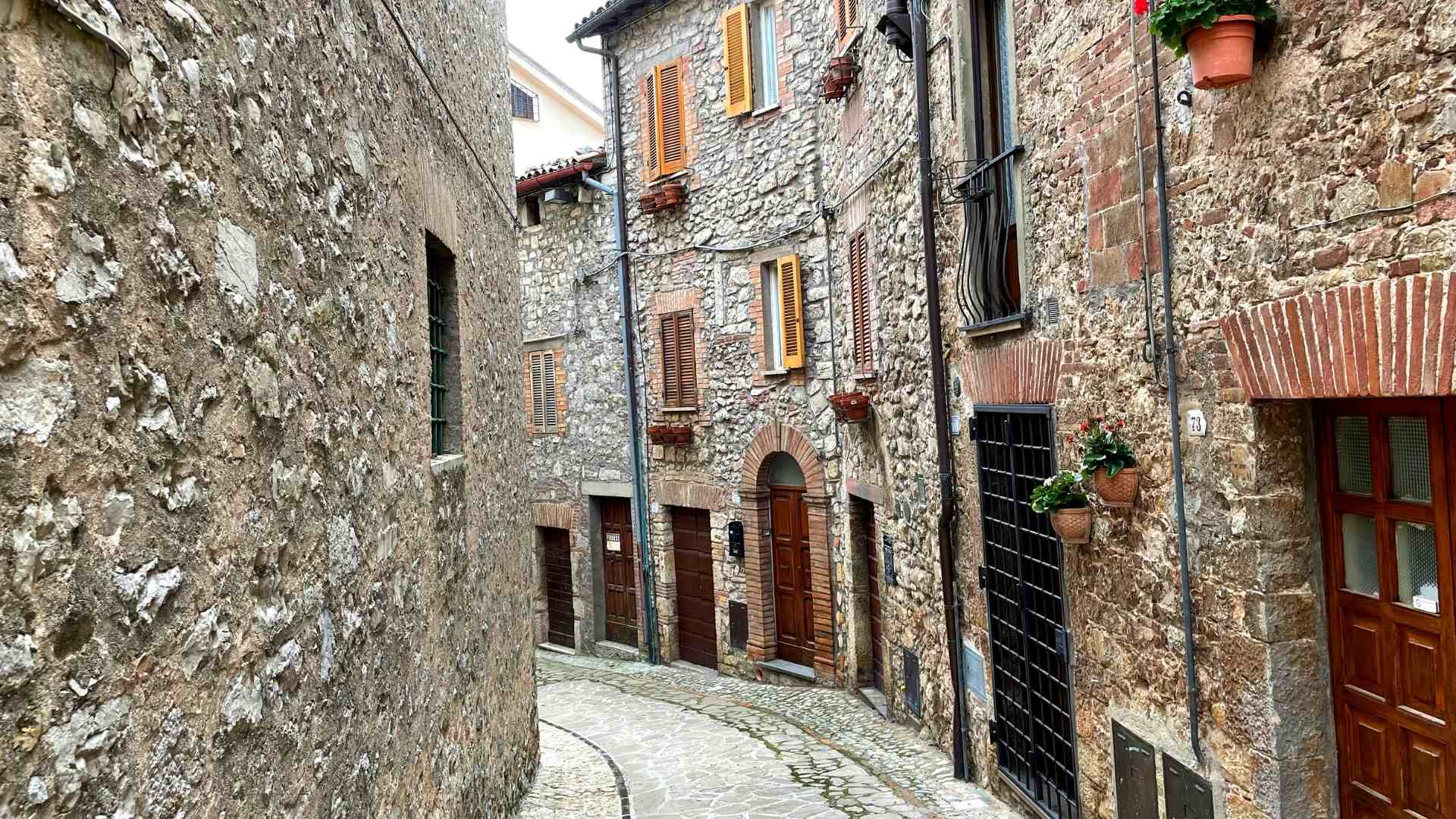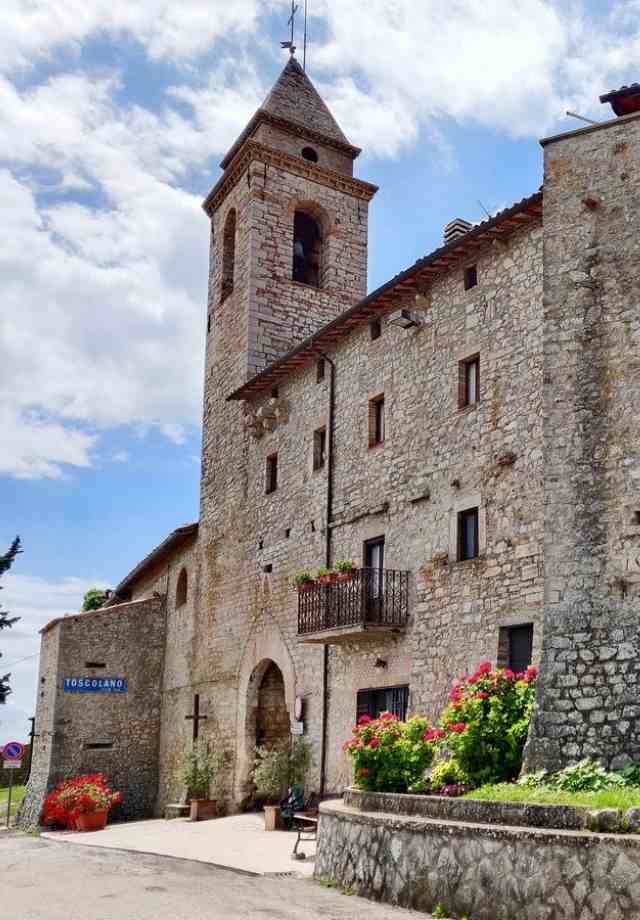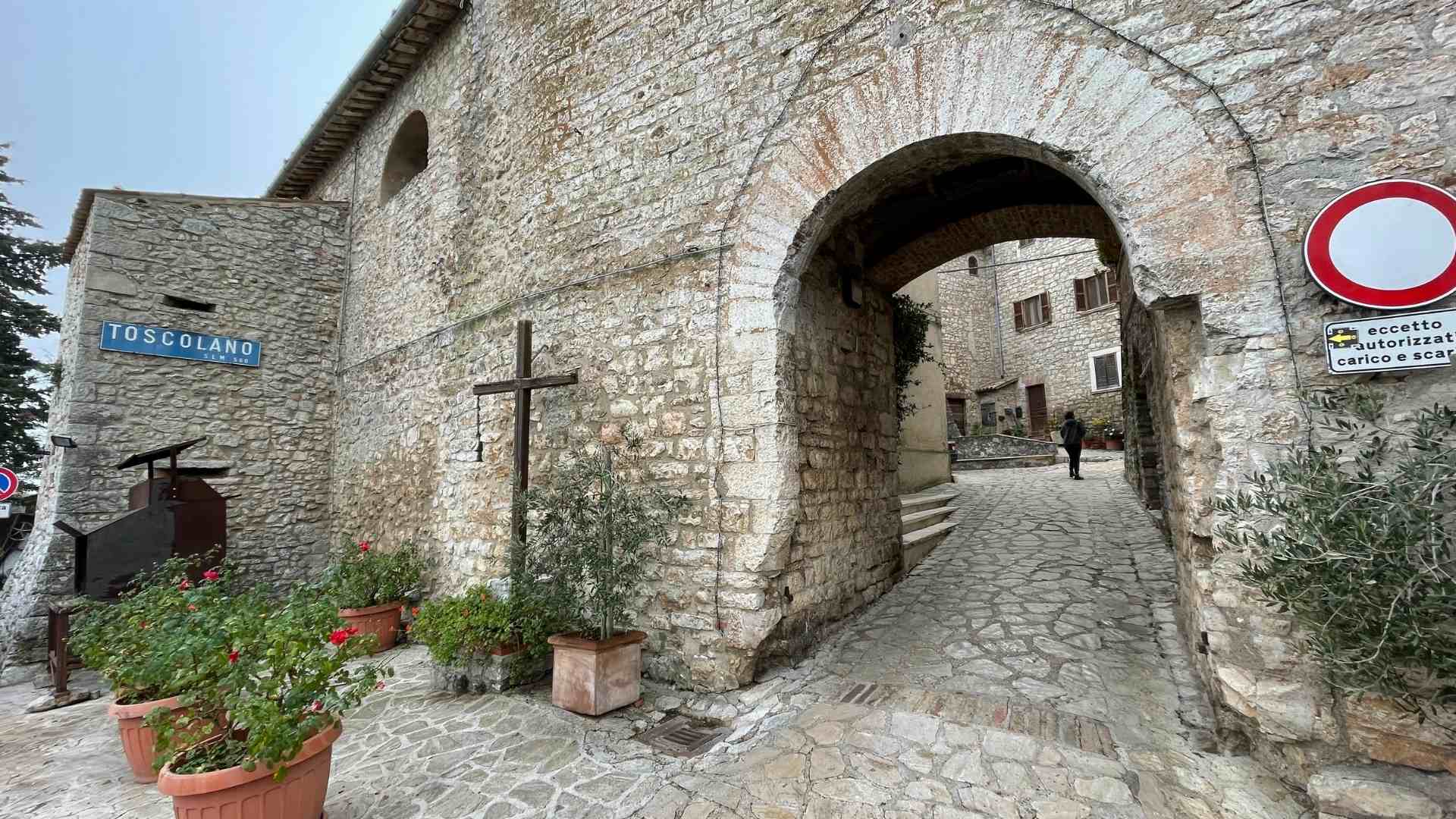
punto di interesse
point of interest


Toscolano, characterized by its characteristic circular shape of a medieval castle, today it is a splendid village leaning against Mount Croce di Serra surrounded by the colors of the beautiful centuries-old chestnut woods that almost embrace it.
Part of Avigliano Umbro, this town, in addition to preserving the suggestive structure with walls and towers, preserves a silent stone village and, in the territory, that Villa dei Ciclamini that has become the home of the inimitable genius of Mogol who made it his residence and his school of the arts.
Although a tradition wants that the toponym derives from the Roman gens Toscola and from a rural settlement from which the castrum derived, there is no certain information on the origin of the country.
It seems likely that a fortress was built at the beginning of the eleventh century, in the period of the Arnolfi, certainly passed to the dependencies of Todi between the twelfth and thirteenth that made it its outpost.
At the end of this last century, Toscolano became part of the parishes of the church of Santa Maria in Gallazzano, once within the walls of the nearby Santa Restituta.
It was in the fourteenth century that, under the impetus of Cardinal Albornoz, it returned under the control of the Papal States. In 1492 it was involved in the diatribes between Guelphs and Ghibellines that shook the entire territory: it was the Liviani family of Alviano to restore the structures.
Toscolano, as well as the other castles in the area, was also devastated by looting and robbery and had to face the descent of Charles VII in what is known as the “chalk war” that brought about three thousand soldiers to settle in these areas, weighing heavily on the economy and food.
In 1595, this castle was the birthplace of Luca di Domenico Bartoli, known as Monk Faostino from Toscolano who, studied in the convent of San Pietro in Montorio in Arabic, between 1633 and 1644 undertook a long journey to the Holy Land.
His chronicle “Itinerary in the Holy Land” has come to us intact and describes the historical and political reality of those lands in that period.

Toscolano, characterized by its characteristic circular shape of a medieval castle, today it is a splendid village leaning against Mount Croce di Serra surrounded by the colors of the beautiful centuries-old chestnut woods that almost embrace it.
Part of Avigliano Umbro, this town, in addition to preserving the suggestive structure with walls and towers, preserves a silent stone village and, in the territory, that Villa dei Ciclamini that has become the home of the inimitable genius of Mogol who made it his residence and his school of the arts.
Although a tradition wants that the toponym derives from the Roman gens Toscola and from a rural settlement from which the castrum derived, there is no certain information on the origin of the country.
It seems likely that a fortress was built at the beginning of the eleventh century, in the period of the Arnolfi, certainly passed to the dependencies of Todi between the twelfth and thirteenth that made it its outpost.
At the end of this last century, Toscolano became part of the parishes of the church of Santa Maria in Gallazzano, once within the walls of the nearby Santa Restituta.
It was in the fourteenth century that, under the impetus of Cardinal Albornoz, it returned under the control of the Papal States. In 1492 it was involved in the diatribes between Guelphs and Ghibellines that shook the entire territory: it was the Liviani family of Alviano to restore the structures.
Toscolano, as well as the other castles in the area, was also devastated by looting and robbery and had to face the descent of Charles VII in what is known as the “chalk war” that brought about three thousand soldiers to settle in these areas, weighing heavily on the economy and food.
In 1595, this castle was the birthplace of Luca di Domenico Bartoli, known as Monk Faostino from Toscolano who, studied in the convent of San Pietro in Montorio in Arabic, between 1633 and 1644 undertook a long journey to the Holy Land.
His chronicle “Itinerary in the Holy Land” has come to us intact and describes the historical and political reality of those lands in that period.

The medieval town preserves the characteristic circular structure surrounded by a wall with quadrangular and cylindrical towers, with the so-called Corte Liviana in the center, so called in honor of the family that rebuilt the castle in 1492.
Between the walls of the Church of S. Apollinare of the eighteenth century that houses paintings of the seventeenth century by Andrea Polinori and Pietro Paolo Sensini and an ancient organ in olive wood.
Just outside, of enormous interest is the Church of Madonna dell’Annunziata with the aedicule of the Majesty attributed to Piermatteo d’Amelia, a fresco representing an Angel, the Eternal Father and the Virgin.
Toscolano is also famous for the Villa dei Ciclamini, where Giulio Rapetti, aka Mogol, founded the CET, Centro di Eccellenza Universitario della Musica Popolare a school that trains new professional figures of music, set in the harmonious nature of Umbria.
Vicino Toscolano passano quei sentieri che partono o arrivano nei pressi di Santa Restituta che dista poco più di 3 chilometri:
There is also the Path 746 – Alta via dei monti amerini and the first stage from Tenaglie to Melezzole – of the Way of the Silent Villages.

The medieval town preserves the characteristic circular structure surrounded by a wall with quadrangular and cylindrical towers, with the so-called Corte Liviana in the center, so called in honor of the family that rebuilt the castle in 1492.
Between the walls of the Church of S. Apollinare of the eighteenth century that houses paintings of the seventeenth century by Andrea Polinori and Pietro Paolo Sensini and an ancient organ in olive wood.
Just outside, of enormous interest is the Church of Madonna dell’Annunziata with the aedicule of the Majesty attributed to Piermatteo d’Amelia, a fresco representing an Angel, the Eternal Father and the Virgin.
Toscolano is also famous for the Villa dei Ciclamini, where Giulio Rapetti, aka Mogol, founded the CET, Centro di Eccellenza Universitario della Musica Popolare a school that trains new professional figures of music, set in the harmonious nature of Umbria.
Vicino Toscolano passano quei sentieri che partono o arrivano nei pressi di Santa Restituta che dista poco più di 3 chilometri:
There is also the Path 746 – Alta via dei monti amerini and the first stage from Tenaglie to Melezzole – of the Way of the Silent Villages.

Continue the tour of Toscolano or its surroundings:
Discover the Church of S. Apollinare
Reach the Church of Madonna dell’Annunziata
Reach Santa Restituta
Or discover the points of interest of Avigliano Umbro and its territory:
[Avigliano Umbro and its territory – link a itinerario]
Avigliano Umbro e il suo territorio
discover all the points of interest of the village
Information, appointments and travel proposals on:
The Progressive Web App is part of the project “Le Terre dei Borghi Verdi”, realized in collaboration and with the contribution of Regione Umbria – Assessorato al Turismo
©2021 Le Terre dei Borghi Verdi
Le Terre dei Borghi Verdi
Welcome in Southern Umbria,
where the slowness becomes value
Information, appointments and travel proposals on:
The Progressive Web App is part of the project “Le Terre dei Borghi Verdi”, realized in collaboration and with the contribution of Regione Umbria – Assessorato al Turismo
©2021 Le Terre dei Borghi Verdi